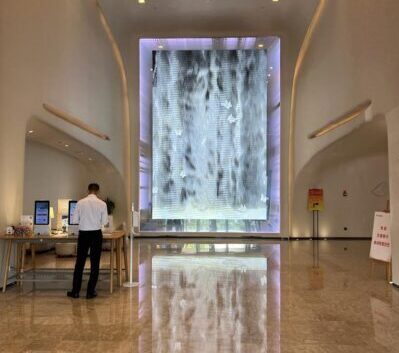
A well-known Brazilian agent told me about the futuristic Flyzoo Hotel soon after it opened in 2019. As it turned out, I was unable to visit this 290 Room 4-star hotel packed with the latest hotel technology until a month ago, after Covid had passed. I had ventured to Hangzhou, the hometown of Jack Ma, the business genius who in the late nineties launched Alibaba, now a golgothan Chinese B2B company that helps many importers around the world connect with exporting Chinese factories. For most people that would be achievement enough, but this legendary titan went on to found Taobao and Tmall, the Chinese equivalent of Amazon, and as part of that developed Alipay, one of China’s two national payment systems, from which he then ventured into the financial and credit services in the form of Ant Financial and then into cloud services. The Flyzoo Hotel, developed by his e-commerce company, Alibaba, and located within its business campus on the outskirts of Hangzhou, incorporates the latest in digital technology. Given his track record in disrupting industries, this was surely worth a visit.
Before I describe the Flyzoo Hotel, let’s first put it into its proper context. As a leading luxury tour company, Imperial Tours typically accommodates its guests at the finest hotels in China, themselves often amongst the finest in the world. Typically, these are full-service hotels with multiple restaurants and bars, less than 200 rooms and a high staff to guest ratio. Given that most leading properties in China are relatively new and spacious, what distinguishes the crème de la crème is the quality of their highly personalized service, and you can’t get great service without amazing staff, fabulous IT, efficient management and subsequently high room rates. This is not the basis on which the Flyzoo Hotel should be judged. This property by contrast seeks to excel in functionality rather than in service. It aims to feed and accommodate its guests in comfortable 4-star circumstances efficiently. That is its purpose and how it should be judged – against a Holiday Inn rather than the Four Seasons.
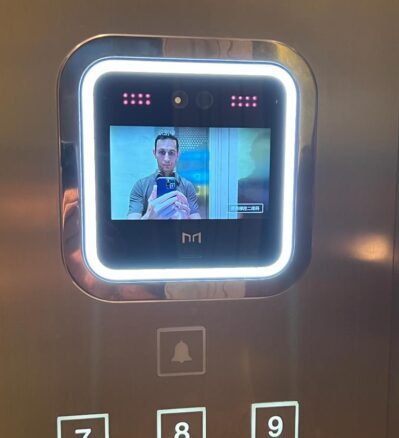
Chinese domestic travelers begin to interact with the Flyzoo Hotel by booking a room on the Alibaba travel app, Fliggy. This allows them to specify both the floor and view in the chosen room category for their stay. They subsequently use this app again to check in to the hotel on their day of arrival – scanning their ID Card and taking a digital photograph of their faces. This image will be incorporated into the hotel database’s facial recognition software. As a result, when they enter the hotel elevator, their floor will automatically be selected. Their room door lock is equipped with the same software. A camera mounted on the door recognizes and admits them to the room automatically. Sadly, foreigners cannot use the app in the same way yet; overseas visitors must scan their passports and take a facial photo at a booth in the lobby as part of their check-in process. Although there is a bell boy in the lobby to help with bags and also a Front Desk manager loitering in the background, these don’t really have much to contribute in the check in process.
The most useful service-provider in the hotel lobby is in fact a mobile robotic concierge. As this pleasant-looking and sounding Chinese-speaking appliance glides its way towards you, a list of informational menu options lights up on its welcoming screen to be selected. Amongst other options, you can ask it to introduce you to the hotel, for directions to the restaurant, or to explain the check-out procedures.
Exhausted by my exertions with the robotic dancing queen, I made my way to the room. As you can see in these images, this is comfortably, efficiently and functionally furnished in keeping with expectations for a four-star property. Though there are mounted wall switches to control the lights, temperature and curtains, each room is equipped with a Chinese-speaking virtual assistant, the equivalent of Apple’s Siri or Amazon’s Alexa. This can be commanded in Chinese to adjust the room environment along with the TV set and music system. Additionally, if you require anything delivered to the room, from a bottle of water to a particular type of pillow or a room menu item, the virtual assistant will organize for a robot to supply this.
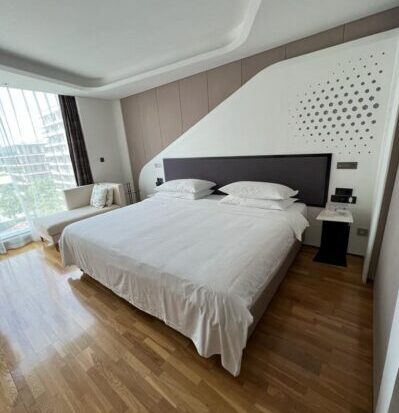
Humans and robots work in tandem in the dining areas. Chefs labor in the dining room’s western and Chinese cooking stations. Meanwhile, QR codes on the table tops direct diners to online restaurant menus and meal ordering programs. Shortly after inputting a table order, dishes are delivered by robots to the table. Diners have to be prompt in removing the food from the drawer at the top of the robot.
Where humans are most in evidence both in the bedrooms and in the dining rooms is in cleaning things away. Neither housekeepers’ nor busboys’ functions have yet been automated. It is an ironic comment on the future of hotel employment that the positions with the lowest paying salaries seem to be safest from being automated.
Whilst the claim will be made that a highly automated hotel makes for a soulless experience, travelers who travel at the 3 and 4 star level are value rather than service-driven. I am not expecting a remarkable service experience when I book an overnight stay at the Holiday Inn, for example. My exchanges with staff will be prompt, utilitarian and efficient. A booking in this segment focuses on value as comprised of a number of factors including price, cleanliness, comfort and convenience. The labor savings that the application of inexpensive technology and robots can provide definitely confer competitive advantage, and the Flyzoo hotel rooms seem like a great deal for the price. While some technologies such as facial recognition software and virtual assistants are bound to be incorporated into the finest hotels, I am not expecting a robotic concierge, even an all-dancing one, to replace the Peninsula concierge or the St. Regis butler anytime soon.
In May 2023, during my first visit to China after the pandemic, I was astonished by the development of Xi’an. “How Has Covid Changed China” chronicles the transformation of this previously unkempt city into a more modern metropolis of gleaming towers and high-tech zones interconnected by elevated expressways, metro lines and buses set on a canopy of lake-centred parks and green spaces. It was like time-traveling from 1980 to 2025 in the space of four years.
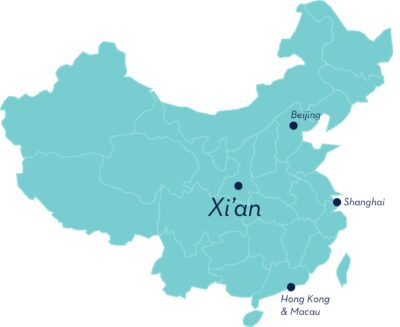
To understand the forces behind Xi’an’s incredible leap over the past five years, we need to look at government policy towards Xi’an over the past forty years, but particularly either side of the launch of the Belt and Road Initiative (BRI) of 2013. Prior to the BRI, exports routinely traveled from China to the rest of the world eastwards by ship. And as Xi’an is in western China, she was facing irrelevance and obsolescence.
China’s reforms of the 1980’s had led to a widely-celebrated economic boom along the east and south coasts where customs-exempt manufacturing zones located by rapidly growing ports were exporting a range of low-cost goods around the world. Meanwhile, because of poor inland infrastructure, foreign investors shied away from Xi’an which subsequently suffered slow growth and emigration. This imbalance was addressed by President Jiang Zemin’s “Go West Campaign” of 1999 which between then and 2006 prompted public investment of more than ~US$140 billion in transport, energy and connectivity to develop the attractiveness of western regions for investment. To forestall inevitable environmental complaints about this steel-woven carpet of concrete infrastructure, ecological protection along with education, were incorporated into the policy from the outset – over a million hectares of farmland and wasteland were converted into forest with farmers compensated for their resulting loss of income.
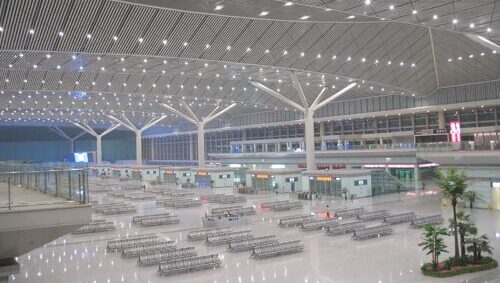
This long-term planning, a characteristic of Chinese governance, from two-decades ago is coming to fruition now. Apart from building smart new highways for China’s burgeoning middle classes and road-hauliers, a second airport terminal was completed in 2003 and a third in 2012. Also, Xi’an’s connection to China’s expansive high speed railway system, the largest in the world, was facilitated through the construction of Xi’an North Station. And again with an eye on the environment, investment was planned for a city metro system whose 9 lines covering 263 miles (423 km) opened between 2011 and 2023.
However, this first phase of development, pre-BRI, received a disappointing response from foreign investors. On the one hand, this was because the strategy had all been directed by the government which made western business people uncomfortable, and on the other, it was because it was ultimately misdirected. The billions spent on improving the infrastructure and educating the local workforce still did not compensate for the easy convenience of locating manufacturing capacity in the vicinity of the already established shipping hubs with their teaming populations.
This state of affairs was to be radically changed by President Xi Jinping, whose hometown is a one-hour drive from Xi’an. In 2013 he launched the Belt and Road Initiative (BRI), prompted by three separate factors. Firstly, China still needed to address the longstanding economic imbalance of its underperforming western regions. Secondly, Xi realized that China’s reliance on shipping for all its exports created a significant trade, economic and military vulnerability – any geostrategic rival could bring China to its knees by blockading the Malacca Straits through which nearly all China’s shipping passed. Lastly, as a result of the massive stimulus it unleashed following the 2008 financial recession, China had developed over-capacity in infrastructure-related capabilities, particularly in steel and concrete production. Coupled with a need to diversify its asset holdings from an over-reliance on US bonds, it saw an opportunity to leverage its infrastructural know-how through an international development loan and export program.
So what is the oddly-named Belt and Road Initiative? (BRI for short) Translated uncomfortably from the Chinese, “belt” and “road” refer to two different sets of envisaged trade routes. “Belt” describes the web of historic overland trading routes popularly referenced as the “silk road” linking Europe and China via Mongolia, Russia and Central Asia. This ancient commercial network has already been significantly rejuvenated through a gargantuan Chinese-built infrastructure program and even now continues to receive more investment from both China and participating countries. Xi’an has always been at the Chinese terminus of that network.
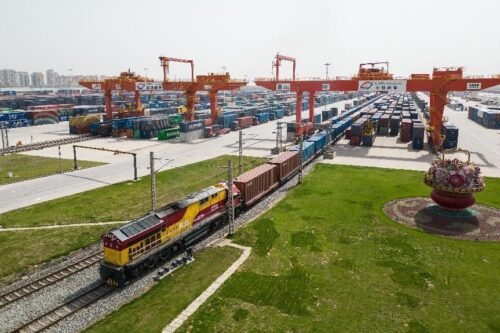
“Road” relates to a more logistically ambitious goal for China to access the Indian Ocean via complex corridors through South East Asia (particularly Myanmar) and via the adjoining Arabian sea through the Pakistan Economic Corridor. The westerly cities of Chengdu and Chongqing, which along with Xi’an form the “West Economic Triangle Zone”, are the gateways for this route. The BRI is therefore intended to increase China’s strategic resilience by reducing its reliance on the eastern and southern seaboards for exports. Of course, by reducing the cost and time to transport cargo from China westwards by rail to Europe, the BRI necessarily increases the attractiveness of western regions for foreign direct investment.
Although you wouldn’t know it from reading the papers, both foreign and local companies jumped at the logistical advantages of the BRI. The American company HP was an enthusiastic early adopter, proud to replace a 37-day journey from China to Europe eastwards by ship in 2009 with a 15-day journey westwards by rail ten years later. As a result between 2018 and 2019, rail volumes from Xi’an to Europe increased by a factor of 6! Then, in 2019 the volume of rail travel between Europe and China almost doubled. Suddenly, the western region boomed. And Xi’an was the place to be. In 2019, the government supported the rail project with an International Trade and Logistics Park along with a bonded area in an accompanying High-Tech Industrial Development Zone for cross-border e-commerce. Money poured in. Xi’an profited from US$31 billion of investment in private investment in 2019 alone. The city’s population grew from 6.2 million in 2013 to 8.8 million in 2023 and – despite the accelerated pace of construction – house prices rose 46% between 2016 – 2019. Similarly, the value of the city’s GDP or production tripled from US$57 billion in 2013 to US$156 billion in 2022. As a result of its fast population growth, Xi’an was able to extend its city limits and allocate more land to its fast-growing Qujiang District, where many of its new and soon to come luxury hotels are located. When I arrived in Xi’an in March 2023, having not been there since 2019, I was utterly astonished by the tail end of all that investment.
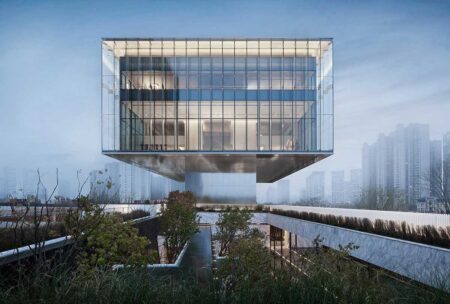
But Xi’an may well have hit its apogee just as Covid hit, because the pandemic has partly cut off the oxygen on which Xi’an thrived, namely foreigners’ access to the city. By June 2020, new business registrations had fallen by 40%. Tourism, along with equipment manufacturing and service outsourcing, was one of Xi’an’s pillar industries. Although domestic tourism provided some support, international tourism was completely interrupted from 2020 until March 2023, and because of reduced airlift to and from China, it is still only now beginning to recover. Furthermore, the conflict in the Ukraine and US sanctions on Russia have complicated Europe-bound rail logistics, though attempts are being made to create a new route that skirts Russia’s southern border across the Caspian Sea and the South Caucasus to Europe. Lastly, the economic and military standoff between China and the US has spilled into its relationships with Western Europe, Japan and South Korea, nullifying the Foreign Direct Investment on which Xi’an’s recent success and strategy has been predicated.
Following twenty years of continued investment Xi’an positively glistens. Expensively constructed government, commercial and residential buildings embellish a state-of-the-art infrastructural plan of social utopianist promise. However, tourism, a pillar industry, and reliance on continued foreign direct investment are being held hostage to the geopolitics of the moment. Without some kind of thaw in China’s relationship with western countries, Xi’an’s regeneration and even the ingenuity of the BRI are liable to stagnate. I and many Xi’an residents hope the world can find a way to avoid this fate.
The glittering J Hotel, housed atop China’s tallest building, The Shanghai Center, the third tallest in the world, curvaceously soars 128 floors over the world’s most stunningly glorious futuristic cityscape in an opulently Las Vegas-inspired flight of fancy. With a Shanghainese restaurant on the 120th floor, it’s currently the world’s highest hotel. Indeed, it’s a hotel of China luxury travel superlatives, whether you count the tiles of the Italian mosaic walls in its presidential Shanghai Suite, the sparkling prismatic refractions of French and Chinese crystal in its glass-faced bedrooms, the numerous international and Chinese works of art sprinkled throughout the public areas or, more blandly, the sheer financial cost of this absolutely gorgeously designed skyscraper. It’s also a story of firsts. Though they are the owners of many fine heritage hotels in the city, such as the Peace, Park, Metropole and Jinjiang Hotels, this is the first time the Jinjiang group is attempting to manage a first-tier luxury hotel. This is also the first time, the world has heard of the new “J Hotel” (J for Jinjiang). And whilst, there are various mainland Chinese-owned and managed five-star hotels, this is the first time a mainland Chinese brand, private or public, is asking to be judged as best in class at the luxury level anywhere in the world (as defined by consistently justifying highest city ADR).
To lead the charge, they have employed a veteran China hand, Richard Yap from Singapore. He has an extensive resume incorporating western luxury brands from Aman to Raffles along with mainland Chinese ones such as the Beijing Commune. He knows the standards expected of top tier luxury China hotels and has the local experience necessary to work within a local work style and management structure. Aware that he needs to achieve exemplary service levels, he has convinced his task masters to invest in a team of well-trained butlers. These are to coordinate service delivery between the various hotel functions to demanding guests, both domestic and international. Of course, because of Covid, so far most hotel users have been mainland Chinese. Like many China luxury hoteliers, Richard is keen to have the opportunity to take his staff and property to new heights by excelling with a smorgasbord of nationalities. He commented – “western and Chinese guests focus on different parts of the hotel experience, and we want to be able to cater to both”.
Jinjiang International Holdings is the largest travel conglomerate you have never heard of. With significant shareholdings in a number of major hotel groups such as Accor, Radisson and Louvre Hotels, as well as Shanghai Disneyland, this aggregation of four listed state-owned companies manages over 7,700 hotels in 67 countries, a fleet of 10,000 vehicles and is a major outbound tour operator. It is the fifth largest hotel group in the world, and J Hotel is its calling card.
Occupying the 84th to 120th floor of the Shanghai Center, J Hotel features 165 bedrooms including 34 suites. It peers down at the neighboring 101 floor Park Hyatt and the stunning 88 floor Grand Hyatt beneath, themselves the third and sixth highest hotels in the world, creating between them an iconic architectural triptych that has come to define the Liujiazui skyline as distinctly as the Peace Hotel and HSBC building define the early twentieth century Bund across the river.
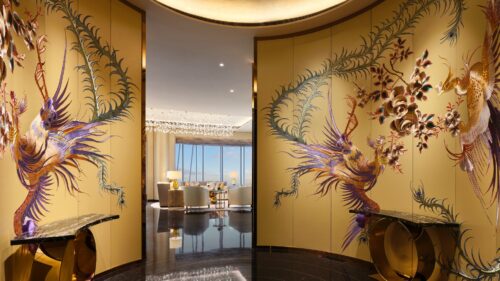
Imagine the “Contemporary” guestroom as a crystal box suspended in a glass skyscraper. 610 square feet (61 sq m) large, the space is sectioned with movable semi-transparent screens into dressing, sleeping and washing areas. Laminated glass with a magnolia pattern contains the white marble-floored bathing area. The chief decoration in the sitting area is an Italian crystal display case featuring Lalique and Chinese glassware with some Tang-dynasty inspired ceramics. A more recent selection of guest rooms are styled as “New Chinese” – the key differences being a more typical and firmer division between bathroom and bedroom areas and more traditional Chinese decoration such as a wooden tea table and gold-accented sofa. The suites, starting from 1,000 square feet (100 sq m), echo the Contemporary style. Their apotheosis comes in the extravagance of the Shanghai Suite – highlights include two large embroidered phoenixes from Suzhou in the round entry vestibule, a crystal structured four poster bed and a yinyang double sink in the bathroom, whose walls are covered in incredible mosaics, reminiscent of the 120th floor Shanghainese restaurant. The flamboyance of this suite is uncharacteristic of the conservativeness associated with East Asian business culture, but typical of the adventurousness that drives it.
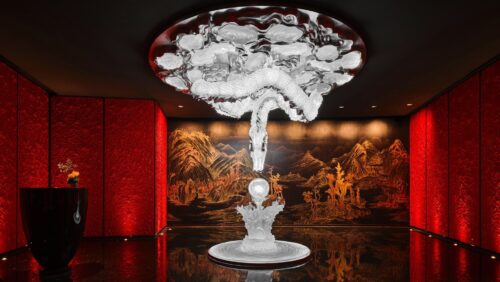
Although it’s hard to decide, to my mind the most stunning area of this incredibly ambitious hotel is in the Cantonese restaurant – “Jin Yan”. One passes through a red glass “Shikumen style” gate into a dark, black-marbled corridor at the end of which coiling down from the ceiling towards a pearl beneath is an illuminated pale blue Chinese dragon. As this is reflected in the black marble floor, we in fact see two dragons fighting over a pearl between them, a traditional Imperial motif that you will also see frequently in the Forbidden City. If this is not magnificent enough, the private dining rooms, styled around the colors of the traditional, five Chinese elements offer their own artistic apotheoses. One dining room’s ceiling is entirely decorated in spirals of dark blue crystal peacock feathers; another features illuminated white crystal clouds. Really, each room belongs in a museum. And all of it overlooks a vast city panorama in which fifty story buildings appear as inconsequential grey stumps of uncouth concrete in the lowly distance.
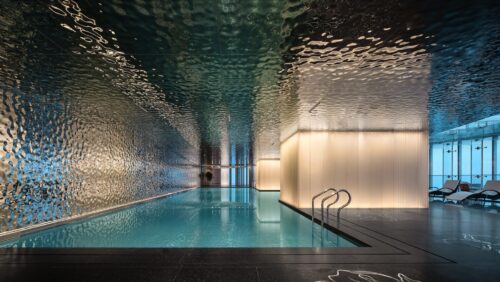
Although the gym on the 85th floor is spacious and admirably well-equipped and the view up to the roof from the swimming pool on the 84th floor in the outer shell of the skyscraper gives an amazing perspective, I do have two criticisms of the hotel in this area. The first is that the exercise and swimming area do not include a steam or dry sauna amongst their facilities. (That said, some of the suites do come with their own individual dry saunas.) The second is the stubborn insistence of Shanghai city government that hotel residents wear swimming caps in the city’s swimming pools. This outmoded regulation is rarely enforced at luxury hotels in other cities in China, and I suggest firstly that Shanghai be advised to phase it out and secondly and more controversially that J Hotel be encouraged not to enforce it.
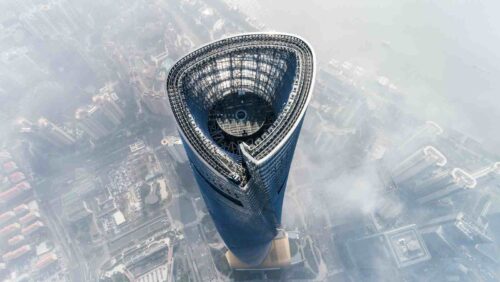
Although a hotel guest is bound to find a satisfying morsel to eat at one of the Italian (101st floor), Shanghainese (120th floor), Cantonese (103rd floor) or Japanese (104th floor) restaurants, it would be criminal not to mention the wonderful tea/light dinner service that is available to all hotel residents every day at the Yi Lounge on the 84th floor on a complimentary basis. My son and wife had a marvelous time enjoying its tasty delicacies, perhaps only matched by the pastries that are available in the patisserie on the ground floor to people rushing to or from this property. That said, rushing this hotel does seem misguided. It is indeed entirely worthwhile to follow one of the tours of its many art holdings. An abiding highlight of my stay at the J Hotel is the access the property was able to give to the “Eye” on the 126th floor. This is a sculpture in the shape of an eye that sits atop a massive 1,000 ton damper that is attached by steel cables to the top of the building. As in other skyscrapers, this “tuned mass” damper system provides a counter-veiling force in the event of a typhoon, preventing the building from swaying. The building’s curved design, running through a 120 degree turn also helps it pass more easily through such weather systems. Although the light show that accompanied my visit would appeal to few adults, seeing the technology, with echoes of Sauron’s Tower from Lord of the Rings, was an eye-opening experience.
The J Hotel is a bold statement, characteristic of a city and country that sees itself as going places. Love it or hate it, it’s difficult not to be thrilled and impressed by it. Certainly, it raises the stakes for other leading hotels of this iconic metropolis. On one bank of the Yangzi River, a visitor sees a handsome array of early twentieth century Art Deco buildings. In their day, these grandiose buildings bespoke the power and reach of the British Empire. On the other, dwarfing them, you now have the most resplendent architectural statement of the twenty-first century, and towering over it all is the J Hotel.
The reopening of international travel to China in March 2023 has introduced visitors to changes in rules for accessing Tiananmen Square and for buying tickets to the Forbidden City in Beijing. If you are working without the help of a luxury tour operator such as Imperial Tours, which can organize these tickets as part of an custom package, but want to organize these activities for yourself, the instructions below detail how to do it.
To Access Tiananmen Square (Without Visiting The Forbidden City)
As of 2021, travelers must make a reservation to Tiananmen Square at a particular time to access it. The most convenient way to organize this is to download the Wechat app and look in the search bar for a mini-app called “天安门广场预约参观”. Unfortunately, an English language version is not yet available. Double-click on the mini-app to open it and then click on “个人预约” which means “Individual Ticket Ordering”. The next screen in Chinese provides dates for entry. Once you have selected a suitable day, the next screen offers four choices: 升旗 (flag raising for which you should arrive before dawn), 上午 (morning), 下午 (afternoon), and 降旗 (flag lowering in the evening). The following screen asks for the personal information of every visitor including the surname (姓名), type of identity document (证件类型), for which your answer should be passport (护照), passport number (证件号码) and mobile phone number (手机号码). Please note that families with children under 6 years of age or less than 1.2 meters (47 inches) in height should request children (儿童). Once you complete this information for all the passengers, you will arrive at a screen with a reservation number detailing your visit time along with your total adult and children tickets.
Now that you have reserved a time to visit, you should proceed to one of the entry points to Tiananmen Square at the reserved time, remembering to take your passports with you. There will be a line for the security inspection prior to accessing the square where your passport will be confirmed against the reservation system, you will be asked to pass through a metal detector scan and any bags you have with you will be examined. If it is a hot day, please remember to take a bottle of water!
To Purchase Tickets For The Forbidden City And Tiananmen Square
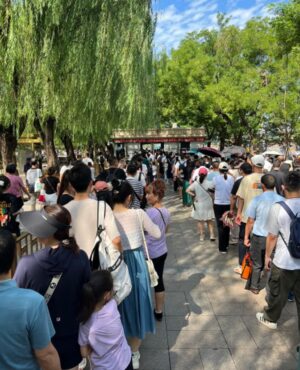
The process for purchasing tickets for the Forbidden City has also become more onerous. Imperial Tours can simplify this for you greatly taking care of all the admin and also reducing the time you will have to queue at the site to collect your tickets prior to queuing to access the site. Should you wish to do this for yourself, you can easily reserve tickets up to 6 days in advance at the English language website. On this website, you select the time for your visit, along with the number of visitors and enter the passport information for each of the visitors. The website charges a US$3 per ticket booking fee and gives you the right to queue up and purchase tickets at 60RMB per ticket before your visit.
It makes sense to arrive at the Forbidden City in good time for your visiting slot as you will need to find your way to the ticket office on the west side of Wumen or Meridian Gate. Once there, you will find there is a queue of 10 – 50 minutes to get to the ticket window, where you can purchase your tickets at 60RMB per ticket. Once you have bought your tickets, you should advance to the queue for entry for individual ticket holders. Fortunately, this is a much quicker queue and you will only need to wait here for about 5 – 20 minutes in order to get into the Forbidden City and start your visit. Note that once you get your reservation to purchase tickets for the Forbidden City, you can automatically use the same reservation to gain access to Tiananmen Square at the same time so long as you are not visiting the flag raising or lowering ceremony – these require a separate application, as described above.
Should you wish to use the services of Imperial Tours to develop a tailored luxury tour package, you will find that you will access both Tiananmen Square and the Forbidden City with shorter or no queue times and far less hassle.
China invested about US$900bn from 2008 – 2023 in a national high speed rail network of over 26,000 miles (40,000km), about 13 times the length of Japan or France’s network. Like theirs, trains are designed to run at between 120 – 220mph. In 2021, during the Covid period, this mammoth infrastructural investment brought in US$104 billion in revenues, representing (according to the Paulson Institute and World Bank) a return of about 7% in lower-carbon generating interconnectivity.
Climate-conscious travelers will wish to use this network as much as possible in their journeys. Other people might wish to learn more about what travel in these trains is like and about the overall value proposition before incorporating certain train routes into their China travel.
Beijing to Xi’an – Time Comparison
For a first-time traveler to China, the obvious route to do by rail is that between Beijing and Xi’an. The fastest high-speed train between Beijing and Xi’an takes 4 hours and 11 minutes. The train arrives and departs exactly on time and the likelihood of a delay is improbable.
Travel time to West Station in Beijing is about 20 minutes from the centre of Beijing, defined as Tiananmen Square, but many travelers will be residing in Chaoyang district on Beijing’s eastern side and so can expect this journey to take 40 minutes or more. On the day of my trial, I was running late and so crossed the station and boarded the train within ten minutes. However, most people will wish to allow at least 30 minutes and tour operators may well wish to pre-book porters, as otherwise clients will be pushing their bags for long distances from their vehicle through the station and onto the train itself.
At the other end, it took me 1 hour to travel by car from Xi’an North Station to the Ritz Carlton in the south of the city. Although this is geographically considerably closer than from Xi’an airport, inner-city traffic resulted in it taking just as long. Door to door the total journey time from Beijing to Xi’an on the fastest train is therefore 6 hours and 20 minutes.
If you travel by plane, it will take you about the same transit time to go by car to T2 or T3 at Beijing International airport about 1 hour in advance. Aviation companies allow 2 hours and 15 minutes but flight time is only 1.5 hours. Assuming airport arrival 1 hour before departure and then 30 minutes at the other end to pick up your bags, then the total journey time by plane is 5.5 hours, or about 50 minutes quicker. That said, whereas train travel happens to the minute, plane travel is subject to more frequent delays.
Comparing Price, Carbon And Other Factors
The three classes of train travel in descending order are Business, First and Second. (Yes, Business is above First.) These are described in more detail in a special section below. Business is about double the price of First Class and more than triple that of Second Class. Traveling in Business by train is priced to be equivalent to the plane. By comparison “First Class” on the train, which offers much more space and comfort than Economy on the plane, is about 20% cheaper than the plane. Second class on the train, which is still slightly roomier than Economy on a plane is about half the price of the plane.
Therefore, if you are a business person prioritizing speed above all else, then traveling by plane wins. However, if the business person has some project work to do, it will be easier to complete it on the train where s/he spends more time in one place, and so it is arguable that even though the transit takes one hour longer by train, it makes for better use of time.
Climate conscious travelers will be aware that train travel results in about 14 – 16 times less emission than plane travel. Families and older travelers should be aware that the total walking distance in train stations is not dissimilar to what you encounter in airports, though the security is less bothersome.
A last consideration for the tourist is that other than skyscapes and clouds, there is little to see out of the window over the course of a plane journey. By contrast, the view from the train is fascinating, affording real insight into the huge progress that the countryside has made over the last 15 years as a result of China’s Poverty Alleviation campaign.
Which Route Makes Sense
A plane travels over 2.5 times faster than the quickest train, and we see that with a train time of 4 hours, the plane already provides a speedier transit, even if the train might overall offer a better value proposition for some people. Routes such as Beijing – Xi’an (4 hours and 11 minutes) Beijing – Shanghai (4 hours and 29 minutes) and Guilin – Hong Kong (4 hours and 7 minutes) might be considered for rail travel. A no-brainer at 1.5 hours would be Hangzhou – Huangshan. Other shorter journeys of an hour or less where the rail network should be considered are those such as Shanghai – Hangzhou, Shanghai – Suzhou or Beijing – Tianjin. I would meanwhile suggest that train routes of more than 4 hours, such as Guilin – Xi’an at about 10 hours, are not going to prove popular when a flight of 2 hours is available.
On The Train – Comparison of Business, First and Second Class
Business Class
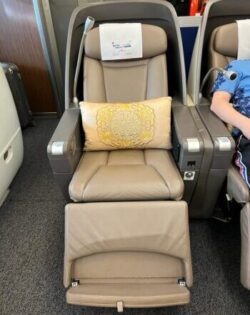
Business class consists of 4 – 6 comfortable, electronically-adjustable, wide leather seats with an electric socket and seat table, exactly as would be found in Business on a plane.
These are contained within their own exclusive, spacious, sealed off cabins in front of the small train driver’s cabin at either tip of the train. Complimentary amenities for business class travelers include travel slippers, ear plugs, ear phones, eye mask, a vanity kit, snacks and complimentary soft drinks. There is a meal service which seems similar in quality to plane meals. Toilets, between compartments, equipped with ceramic sinks and toilet bowl, are spacious and of a cleanliness comparable to western Europe.
First Class
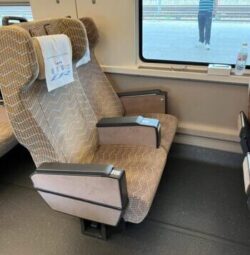
As seen in the photo, first class consists of two seats either side of a central aisle with a very comfortable pitch between seats. A complimentary soft drink is offered to travelers.
Second Class
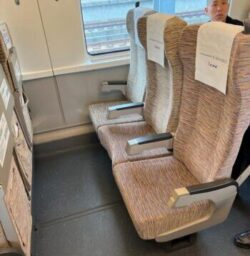
As seen in the photo, second class consists of five seats separated into a 2 and 3 by a central aisle with lesser pitch between seats resulting in more rows within a rail carriage than in first class. There is however still significantly greater pitch in second class on a train than that offered in economy class on a plane. A complimentary soft drink is offered to travelers.
Process Of Getting On And Off A High Speed Train

To use a high-speed train in China, you will need to have your ID with you. For overseas travelers, this will be their passport. You will have a ticket with a hall, train number, carriage and a seat number.
China’s ticketing system has been digitized such that every booked seat is associated with an identity document and number. When you arrive in the station, you will not be able to use the turn-style ticketing barriers for local Chinese travelers because you don’t have a Chinese ID card for which these machines are built. Instead go to the side where an attendant will be waiting with a passport scanner. S/he will scan your passport to check your ID and ticket against the system.
After this ID inspection, expect to put your bags through a baggage X-ray machine. If you are in a large station with multiple waiting halls, you need to walk to your waiting hall. If you are in a smaller station, there will only be one waiting hall. When there, look for noticeboards detailing your train number and the train boarding order.
When your train is called, queue at the barrier to go onto the platform. Again, because you have a passport rather than a Chinese ID card, you will need the help of an attendant to board the train. Once you are on the platform, walk to your carriage and subsequently to your seat number. An attendant at each carriage will help direct you. After you have reached your destination, you will disembark and follow signs for the exit. To leave the station, there will be another ID check before you exit the station.
Conclusion
As a bespoke luxury tour operator, Imperial Tours will always defer to the wishes of its guests in selecting their preferred mode of transport. That said, whilst we previously assumed (non-private jet) guests would travel domestically by commercial carrier thanks to speed and overall convenience, there is now an option for a climate-friendlier alternative for many transits. Given its reduced cost, comfortable spaces, reliability, insight into the countryside and lower carbon emissions, travel by train for journeys of approximately four hours or less offers a compelling alternative.
4 years ago I co-founded Imperial Tours, an inbound luxury tour operator in Beijing, where I lived for 20 years. As a result of the Covid pandemic, I was trapped outside China from November 2019 until three weeks ago when I returned for the first time in over three years. This article describes the changes I found on reopening China’s travel industry.
The Rise of “Genuine” Boutique Hotels
When China first opened to the travel industry in the 1980’s, one of its only sources of foreign currency was the inbound market. Since that beginning the impact of overseas tourists was factored into every decision in the development of the hospitality sector. During Covid however, China was shut off from the outside world and as a result the hospitality sector advanced within its own bubble.
There has impacted a number of things, but one of the most notable has been the rise of the genuine boutique hotel. I write “genuine” because at the first boutique hotel conference in China (at which I spoke), boutique hotels were defined as having up to 100 rooms, which is not how most western travel agents would understand it. However, after being closed off by Covid for more than three years, the spending of affluent upper Chinese classes traveling domestically has caused a mushrooming of interesting boutique hotel alternatives both outside big cities (prompted by the local staycation market) and in China’s longstanding leisure destinations.
There’s of course one problem generated by this organic growth – in many instances, these boutique hotels are ill-equipped to handle foreign visitors. Yangshuo Misty Wonderland Hotel is a perfect example. This luxurious 28 key hotel comprised of villas and very spacious rooms with generous balconies sporting their own capacious baths offers one of the most stunning, if not the most spectacular, view and location in the entire country. (Above photo is of me sitting on a bench located within an ornamental swimming pool in front of the mountainscape.) Not bad, right?
Buildings are styled on the traditional architecture of the Han and Tang dynasties. Yet not only is there not a single staff member able to rub two words of English together, but there are no western dishes on any of the hotel menus. There is no concession anywhere to the potential demands of a non-Chinese speaking tourist – something that would have been unthinkable prior to Covid.
The same is true at the delightfully landscaped Tong Resort in the same area. But do not lose hope – Jora, a 35 room “Small Luxury Hotel of the World”, in the same area had the most resourceful staff at any hotel I have ever encountered and accommodates English speaking guests.
As we move beyond the first phase of China’s reopening, the re-introduction of overseas tourists to China’s inbound market coupled with the reduction in demand from the domestic traveler, will inevitably encourage this new wave of Chinese boutique hotels to invest in services for overseas travelers which can but enrich the market and textured experience of travel in China.
Fewer QR Codes And More Real Menus
If you’re anything like me you stifle an internal groan when you walk into a restaurant and are compelled by the waiter to scan a QR code to browse online to the restaurant menu, which you subsequently peruse with difficulty on your annoyingly limited mobile phone screen. This was a digital innovation introduced during Covid to reduce the spread of infection.
I object to the impersonality of this characterless functionality, and so am cheered by a trend in techno-addicted China tilting in the opposite direction. When I went to dine at Michelin one star, Poetry Wine, I was thrilled to be handed a thick, large format volume with a photo of each dish with its name, price and ingredients printed on individual pages of high-quality paper.
I was dining amongst a group of friends and we all started to discuss the menu and our choice of dishes. The menu prompted an entertaining conversation that became the foundation of a hearty and enjoyable dinner. Ignace Lecleirc, a successful restaurateur and owner of a wide stable of Beijing eateries including the fabulous Michelin one star fine-dining establishment, Temple Restaurant Beijing – Hutong, assures me that this trend is now becoming well-established.
A New Digital Divide In China
When people speak of a digital divide they typically refer generationally to the elderly failing to keep up with the technology of the day, not the bifurcation of American and Chinese internet systems with their separate app universes. Whilst I can travel freely between western Europe and America and use the same apps such as Uber, Booking.com, Google Maps and Whatsapp, that borderless digital experience totally collapses at Chin’s border.
Not only do all apps owned by Google or Facebook not operate in China, but moreover, China’s digital universe is comprised of an entirely different set of apps. For navigation, you would use Baidu or Gaode, the first of which does not even seem to be available to non-China registered accounts. Restaurant recommendations are on Dianping. Ride hailing is on Didi, payment services rely on Alipay or Wechat and ctrip would be used for travel bookings. It’s an entirely different app universe and with the exception of ctrip, which offers trip.com outside China most of these apps are not going to be easy for the traveler to use in China because of linguistic and logistical barriers.
What this means in practice for overseas travelers, for example, is that whilst travelers can always get the hotel concierge to order them a cab to a restaurant, which the concierge would still be required to suggest (as travelers cannot access Dianping’s restaurant suggestions for linguistic reasons), for the return journey, travelers would require the restaurant to order them a cab back to the hotel. It seems that most cab drivers are accepting cash, so payment in that situation is not an issue. However, travelers can no longer presume to be able to hail cabs as these are mostly responding to ride-hailing apps now. These are the kinds of considerations that travelers will need to incorporate within their journeys through China. Increasingly, access to China’s digital services is leaving overseas visitors behind.
Like an anxious child fearing the loss of his mother, so on my most recent trip did I worry about how I might possibly negotiate life in China without my mobile phone. As I participate within China’s digital universe, I understand its reach and ubiquity such that on the one hand I fear for travelers who cannot access it and on the other, I am subsequently insensitive to situations where overseas travelers, particularly independent travelers making their way without the help of a local operator, might struggle with the most basic aspects of digital life there.
Of course, no article on the Chinese internet is complete without emphasizing the need for overseas travelers to equip themselves with a solid VPN service prior to travel there in order to access their favorite western web sites and services. Indeed, I would now recommend travelers subscribe to two different VPN services so that in the event one is blocked or ineffective, they always have the other to turn to and use to gain access to Instagram, Facebook and Google, etc.
The New Greater Bay Area
This is something that has not garnered attention in western media but deserves mention. The Chinese government first documented its intention to create a Greater Bay area in 2017. The idea is to integrate Hong Kong, Macao, Guangzhou, Shenzhen and five lesser known successful, southern cities within an environmentally sustainable and technologically progressive development plan. And when the Chinese government decide on these strategic plans, there’s usually good reason and they usually happen.
So here we are six years later following the construction of interconnecting high speed rail links, bridges and airport clusters along with new rules facilitating the movement of people and goods between these areas. For the travel industry, our attention needs to be focused on Macau in particular as this has been designated the travel hub within the plan.
Already known as a destination for gambling, following a recent crackdown on junkets (associated with money laundering), Macau is seeking to develop alternate revenue streams. Las Vegas provides obvious direction, but in addition, I have been told, significant funds are soon going to be devoted to promoting recreation and the arts across this area.
This message was echoed by Meg Maggio, an art aficionado of many years standing in Hong Kong, who advised that big plans are afoot in the world of art across the entire Greater Bay area, not just Macau. How this will impact travel we will wait to see, but it’s worth just mentioning now.
The No-Show of Outbound Chinese Travelers
As this is relevant but unwelcome, I will cover it briefly. Major travel suppliers in the west might have been expecting a sudden rush of Chinese clients in the wake of China’s re-opening. I am sorry to report that this won’t be happening in the immediate future. As a result of political tensions, countries have been grouped into friendly and unfriendly sets, with Chinese outbound groups able currently to travel only to those deemed friendly. France qualifies as friendly, but UK and US do not for example. Whilst FIT travelers can travel freely, groups are subject to this restriction. I would anticipate that the warming of international relations will quickly address this lagging stricture.
We are still of course very much in the early days of China’s reopening and many of the apparent obstacles, such as the continuing lack of trans-Pacific flights, will surely be bridged in due course. As that happens, no matter if you have already been to China many times, like me you will always find that it has shifted in your absence and that there’s always something new to discover and enjoy.
First published in Insider China Report on June 13, 2023.
If you are like most travelers, the flights to China and back are perhaps the least exciting part of your trip. Depending on your point of departure, you’ll likely have to sit through a 10+ hour flight just to reach the first destination in your tour of China – typically Beijing, Shanghai or Hong Kong. After enduring a couple of days of jetlag, you may not fancy boarding another flight for the next city in your itinerary. Fortunately, at 112,000 kilometers (almost 70,000 miles), China now boasts the longest rail network in the world. Of this, China also leads the world in high-speed rail with a 30,000 kilometer (around 18,000 mile) network. To put this into a global perspective: it’s more high-speed rail than every other country in the world combined. If this network was transplanted to the United States, there would be enough high-speed rail track to zig-zag across the country from Seattle to New York to San Francisco to Philadelphia to Los Angeles to Miami, with an extra 4,000 miles to spare. Also commonly referred to as bullet trains, these typically reach speeds of 350km/h (210 miles per hour) and offer a true alternative to domestic air travel.
Kowloon West Station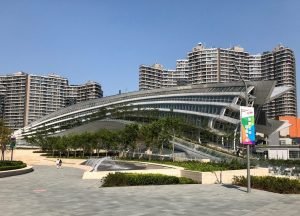
As if it weren’t enough, the network is still being expanded, with ambitious projects reaching across to the remote western provinces of Tibet and Xinjiang. With such proportions, it’s no surprise to see how high China’s rail usage is: in 2019 it was estimated that 3.57 billion trips were made on rail in China, with about 2.29 billion of those on high-speed trains. Many of these are short trips connecting major metropolitan areas such as Beijing with Tianjin (120km in 30 minutes) in northern China, Shanghai and Hangzhou (175km in one hour) in eastern China, and Hong Kong with Shenzhen (30km in 15 minutes) or Guangzhou (130km in 50 minutes) in the south (note: immigration formalities will take place at Hong Kong’s Kowloon station). In fact, whereas flights between certain destinations may be limited (for example between Guilin and Hong Kong, which are not daily) – there are multiple daily railway options instead.
In terms of cross border journeys, Hong Kong is the only high speed option at present, but China otherwise maintains passenger connections with Hanoi (Vietnam), Almaty (Kazakhstan), Ulan Bator (Mongolia), Moscow (Russia) and Pyongyang in North Korea. There’s also a greater frequency of intercontinental freight trains, reaching as far as London, as part of China’s recent Belt and Road initiative.
Flying may still be the most convenient option for covering larger distances, for example from Beijing to Chengdu, but most destinations on the tourist trail easily connect by train. For example, a trip from Beijing to Xi’an, home of the world-renowned Terracotta Warriors, can take as little as 4 hours and 20 minutes by high-speed railway. Although that’s twice as long as a flight, the train stations are closer to downtown, which means you’ll spend less time on transfers, and shorter check-in/security times apply, making door-to-door journey times almost the same. There is no sacrifice in comfort either, with Business Class on high-speed trains featuring fully reclining seats offering more space than most First Class flights, and with luggage allowances more generous. (Note: Business Class is the highest category on Chinese trains and superior to First Class).
Business Class Carriage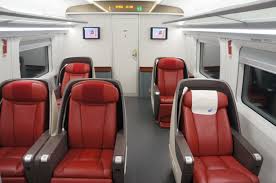
As added bonuses, traveling by rail is more environmentally friendly than air-travel, and the trains typically run right on time – something which unfortunately can’t be said about domestic flights!
Whereas booking Chinese trains can be a challenge (sales begin only one month prior to departure, require payment in China, and copies of your passport) – our team of Itinerary Designers would be more than happy to assist with this, in addition to talking you through the best options available. If air is still your preferred mode of transport, you can also sample the world’s fastest train: Shanghai’s Maglev. This “floating, trackless train” will whisk you the 30 kilometers (18 miles) between Shanghai’s main international airport in Pudong and downtown Shanghai in a mere 8 minutes, reaching a top speed of 430 kilometers (about 268 miles) per hour.
If, on the other hand, you’d like to slow down, there is always the 40 hour train from Beijing to Lhasa, or a 24 hour traditional train from Hong Kong to Beijing! Both will ensure you have plenty of time to soak in every inch of China’s wondrous natural landscape. However, neither are luxury travel experiences nor journeys we would recommend.
In any case, the choices abound.
– Jaime is one of Imperial Tours’ Itinerary Designers.
“How large is China? I have 7 days in China and would like a luxury tour to Beijing, Xian, Guilin, Shanghai and Hong Kong. Is this possible?” As an Itinerary Designer at Imperial Tours, I have been asked this question (or a similar variation) countless times. My initial response is that technically it is possible if one wishes is to zip from city to city with very little time in each destination. But I then continue to explain that China is a large country; flights from one city to the next average 2.5 hours per leg and each of the destinations are markedly different in terms of tourist sites to see, historical significance, culture, as well cuisine.
To put things in perspective, China is about the size of the United States (the USA is in fact slightly bigger, but who’s competing?). This means visiting the aforementioned cities in seven days equates to traveling from Washington DC to Chicago to Las Vegas to San Francisco to Seattle! That would lend to a very ambitious, not to mention a rather exhausting holiday itinerary.
From the standpoint of a traveler seeking an extraordinary China luxury travel experience, I strongly advise clients against covering too many destinations over a short period of time. If clients are constrained by time and are limited to just one week in the country, rather than squeezing in as much as possible, I suggest that they visit fewer cities to allow ample time to truly experience and enjoy each destination. On the other hand, if clients are flexible with regards to time, two weeks is suitable to cover about five destinations without feeling too rushed.
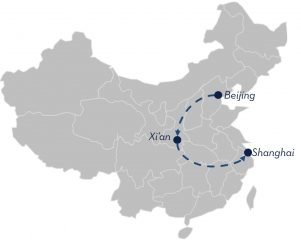
For a first-time visitor who (a) has approximately a week to travel, (b) is eager to obtain a nice overview of the county, (c) seeks a luxury China tour and (d) is open to advice, an itinerary I frequently recommend is: Beijing (3-4 nights), Xi’an (1-2 nights) and Shanghai (3 nights).
As the nation’s capital and political center, Beijing serves as a good logistical starting point and a wonderful introduction to the country. It is home to numerous well-known, must-see historical sites including Tiananmen Square, the Forbidden City, Summer Palace, Temple of Heaven and of course the Great Wall (note, Imperial Tours does not take our clients to Badaling which has a daily quota of 65,000 tourists. Instead we take our clients to a more remote section of the Great Wall that’s a further drive from town, but well worth it because once there, one literally feels that one has the entire wall to oneself! We can even bring you for a bit of trekking to an unrestored section of the Wall). Three days is sufficient to check-off the key sites in Beijing, but an extra day allows for a bit more flex time to embrace additional cultural experiences such as Factory 798 area, the epicenter of Beijing’s art scene; a stroll through gentrifying hutong grey-painted alleyways for a glimpse at local daily life; or a stop at the Lama Temple, a Tibetan Buddhist Temple. Let’s not forget about the culinary delights this northern city has to offer, namely Peking Duck!
From Beijing, a two-hour flight southwest takes one to the ancient capital of Xi’an (concerned about your carbon footprint? Consider a high-speed train from Beijing to Xian which takes 4-5 hours). Despite being the start of the Silk Road, had a local farmer not stumbled across the Terracotta Warrior ruins some five decades ago, one may question if Xi’an would have garnered its popularity as a major tourist destination (that might be the subject of another blog!). If the Terracotta Warriors is all one wants to see, one night will do. However, there are a handful of other sites beyond the Terracotta Warriors that warrant more time such as the imposing ancient City Wall (fancy cycling the 9 mile (14 km) circumference?) and Great Mosque, one of many mosques serving the city’s approximate 30,000 Muslims in heart of the vibrant and bustling Muslim quarter. On the subject of food, Xi’an is popular for sumptuous dumplings in a multitude of shapes and fillings.
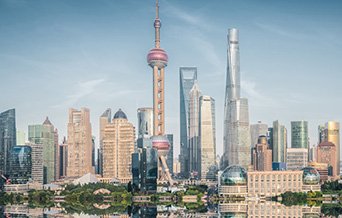
The final stop of a week-long trip is none other than Shanghai. Located on the eastern coast (2.5 hour flight from Xi’an), Shanghai seamlessly blends a vibrant colonial past, the now and the future. Two full days in this dynamic city allows one to get a solid sense for the place. One can wander through sycamore-lined boulevards in the heart of the Former French Concession (perhaps led by a historical expert who can bring to life the bygone era of Shanghai’s colonial history), visit the Yu Gardens (a prime example of traditional Chinese garden design), explore the Shanghai Museum (arguably the best museum in the world for classical Chinese art), engage in some retail therapy (souvenirs to take home) and gaze over the city from the Shanghai Tower’s (second highest building in the world) observation platform. Like any cosmopolitan city, Shanghai also boasts some of the world’s best restaurants – both western and Chinese!
I recall a guide once saying, “Imagine China as a tree. Xi’an symbolizes its roots, firmly steeped in ancient history that spans the course of 5000 years. Beijing represents the tree’s trunk. With a history dating back some 500 years, the political center is solid and establishes the country’s direction. Finally you’ve got Shanghai, characterized by the leaves. It’s susceptible to wind, it’s young and dynamic.” I thought it was pretty good account, albeit simple, to summarize a one-week introductory trip to China.
FOR IMMEDIATE RELEASE: August 14, 2017
Contact: Jacqueline Soto, 480-430-7511, Jacqueline@slentertainment.com
Guy Rubin, +86 10 8440 7162 guy@imperialtours.net
IMPERIAL TOURS GREAT WALL PRIVATE BANQUET RECOGNIZED AMONG TOP TRAVEL EXPERIENCES
Scottsdale, AZ – An experience offered by Imperial Tours was recognized as one of the top experiential travel offerings at the inaugural CHAD CLARK CERTIFIED 25, a first-of-its-kind travel initiative that annually lists the top 25 travel experiences or products throughout the world. The winners were announced in a special interactive event at the Bellagio in Las Vegas on August 13 in front of leading travel professionals.
Chad Clark, principal and owner of Chad Clark Travel Ventures, is a travel industry expert and self-described, “experience junkie,” who has spent years seeking out top-of-the-line travel experiences and services. Now, he is providing a platform for the best in travel to share theirs.
Clark aims to set the industry standard for luxury travel with the inauguration of the CHAD CLARK CERTIFIED 25, an elite list of the world’s most prestigious, authentic and unique travel experiences or products. Great Wall Private Banquet was among the first recipients of this prestigious honor.
“We are humbled and overwhelmed by the immense number of submissions we received from travel providers across the globe,” said Clark. “It is an honor and a thrill to unveil the very best in luxury travel through the CHAD CLARK CERTIFIED 25. This initiative provides travel suppliers with an opportunity to have their premium experiences recognized and promoted in an innovative way, while simultaneously connecting travel advisors, and ultimately travelers themselves, with exclusive, thoroughly vetted travel experiences that have an industry seal of approval.”
About the Great Wall Banquet
When we hear these days of the daunting logistical and financial challenges of building a wall across the southern border of the US, it brings home the magnificent achievement of the Chinese in resolving exactly these issues many centuries before as they built successive fortifications across their northern frontier to protect their agricultural heartlands from aggressive nomadic invaders from the north. These fortifications are known to us today as the Great Wall of China. The incredible experience we are presenting is the opportunity to walk the Great Wall with the British conservationist who was instrumental in developing the law to protect it, and then to enjoy a white linen banquet in a guard tower.
What astounds visitors about the Ming dynasty Great Wall (1368-1644) is its surprising beauty. Whereas the sections closest to Beijing are the largest with the most tourists, more remote sections benefit from fewer visitors and less renovation. The centuries-old 5 meter high “wild wall” – as conservationist William Lindesay calls it – these days does not dominate its surrounding landscape so much as delineate, define and embellish it. William will introduce his thirty year association with the Great Wall, starting with being the first foreigner ever to walk its entire length, to now when he is known through China as the Guardian of the Wall. After a thorough introduction to his efforts to improve its conservation, you will be taken to a remote spot to enjoy a remarkable banquet on the Great Wall of China.
About Chad Clark Travel Ventures
A self-proclaimed “experience junkie,” Clark gave up corporate life to follow his love for food, wine, culture, destinations, a.k.a. extraordinary travel experiences, and turn it into a business that helps people make the absolute most of their most precious commodity – their time.
Whether traveling with friends, family or alone on a research trip, Clark is all about the experience – and when he finds one he is passionate about, he just has to share it with his clients and friends. He and his company have the contacts, relationships and dedication necessary to ensure his clients have the best possible experiences. Clark has dedicated his life to travel and is amassing an ever-growing “Experience Journal” that he shares online through social media. Viewers can follow Clark through Rome, Sydney, Paris and even in his own backyard golfing in Scottsdale, Arizona. Clark and his team are committed to sampling, connecting, building relationships and, in essence, helping his clients live their next big adventure.
Chad Clark Travel Ventures works with people who recognize that the types of trips they want require more than time and planning – they require knowledge, experience and connections, all of which Clark and his team can provide.
Chad Clark Travel Ventures, an independent affiliate of Camelback Odyssey Travel – a Virtuoso® Member.
For more information on CHAD CLARK CERTIFIED 25, please visit www.chadclarkcertified.com.

Marketing China has never been more exciting, easy and profitable. As you may know Imperial Tours has partnered with Peninsula Hotels to bring you Peninsula Private Jet Tours Through China. Through this collaboration we have developed three bespoke travel experiences through China: Culture & Heritage, Family and Culinary. But what you may not know is that we have also developed a marketing plan designed to help you get the word out about these itineraries. Our Marketing Plan gives you the tools you need to promote and share Peninsula Private Jet Itineraries through multiple mediums. The idea behind sharing our marketing plan with you is to take the guesswork out of promoting these experiences. Essentially, let us do all the work for you and all you need to do is share!
These itineraries are packed full of once-in-a-lifetime experiences. If they are booked privately, itineraries can be further customized for alternative dates or embellished with different destinations, and if wished they can also be booked on commercial flights.
Our Marketing Calendar (click to download) is complete with step-by-step instructions on how to market and capitalize on each itinerary. All you have to do is follow five easy steps and let Imperial Tours do the rest.
Follow us on Twitter, Facebook and Instagram to get content on Peninsula Private Jet Tours that you can share with your followers.
Click to download our Marketing Calendar made especially for you. This calendar provides you with a detailed, easy to follow, marketing campaign that you can print out and follow to promote these tours. Additionally, our Marketing Calendar provides you with easy to follow instructions on how to repost and share from Facebook, Twitter, Instagram and E-blast.
Over the next 3 months, starting in November 2016, we will be sending out 3 e-blasts relating to a specific Peninsula Private Jet Itinerary; Culinary, Family and Culture & Heritage. Each e-blast will be created so that you can forward the information to anyone you think might be interested in one of these amazing experiences.
Each one of our 3 e-blasts will have a social share button that allows you to share each itinerary on Twitter, Facebook & Instagram. Simply click the social share button for each social icon and share!
After generating interest in each tour contact us to help you book one of these amazing journeys. Note: private tours based on these scheduled departures can fly commercial and be further customized.
Our Culinary Voyage e-blast will be sent shortly after American Thanksgiving. This one of a kind itinerary provides opportunities for your clients to try their hand at creating traditional Chinese dishes such as Peking duck, Dim Sum and even noodle throwing. China is a “must-eat” destination for all foodies; our Culinary Voyage is a 10-day tour highlighting the best eats China has to offer. Our culinary tour is ideal for groups of 8 or less. Tours are approximately USD$26,050* per person based on double occupancy. To view a detailed itinerary click here.
Our Family Tour e-blast will be sent in early December, in time for Christmas as the perfect once-in-a-life-time holiday gift for the whole family. This 11-day tour showcases the best of China in a safe and family-friendly interactive setting. This tour is ideal for small to medium sized families who are looking for a unique holiday experience and enjoyment for the whole family. Tours begin at approximately USD$102,120* per family of 4. To view a detailed itinerary click here.
Our Culture & Heritage itinerary will be sent out after the New Year and is equipped with unparalleled access to some of China’s most significant cultural artifacts as well as leading creative minds shaping China’s artistic landscape. This 10-day tour will introduce you to private collections and VIP access to China’s cultural treasures. This tour is ideal for clients who are looking for exclusive access to all that China has to offer. This tour is suitable for small groups as well as families. Pricing begins at approximately USD$25,530* per person based on double occupancy. To view a detailed itinerary click here.
*Price is subject to change based on fluctuating exchange rates.